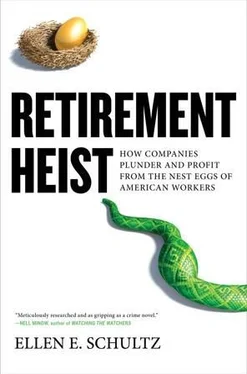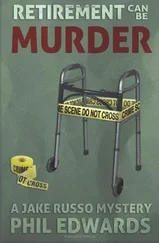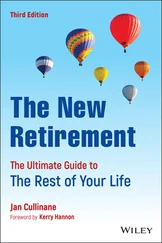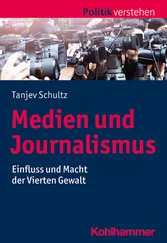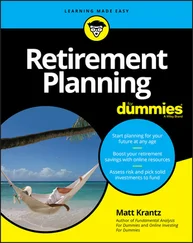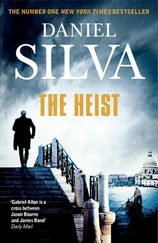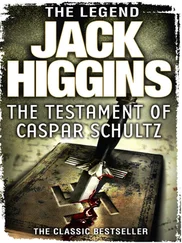If the investments weren’t wrapped in an insurance policy, the company would have to sell the investments, then pay taxes on the gains, if it wanted to be able to report the income. Bottom line: Even though companies aren’t supposed to get tax breaks for funding executive deferred comp and pensions, they get essentially the same tax breaks—and accounting benefits—by taking out life insurance on workers.
Though the investments are essentially locked up in the insurance policies, companies receive tax-free cash when employees and former employees die whether in car accidents, in plane crashes, or from illness. Even people who are murdered or accidentally killed at work produce death benefits for their employers.
Companies report the death benefits as income, though they usually refer to them by opaque terms. The St. Louis–based Panera Bread Company calls them “mortality dividends” and refers to a death benefit as a “mortality income receivable” in its filings.
Banks have the largest obligations for executive pay and pensions, so it’s not surprising that they are also the biggest buyers of life insurance on workers, which they call “bank-owned life insurance,” or BOLI. Industry consultants estimate that over the coming decades, banks will receive more than $400 billion in death benefits as their retirees and former employees die. Financial filings occasionally disclose income triggered by deaths. Pacific State Bancorp, of Stockton, California, reported $2.6 million in income from a death benefit in 2008. A subsidiary of Conseco, Bankers Life and Casualty, bought life insurance on employees in 2006 and got an almost immediate payout of $2.7 million that year after an employee died.
Most families have no clue that their relatives are covered. Irma Johnson certainly didn’t. Her husband, Daniel, had been a credit-risk manager for Southwest Bank of Texas, which was a predecessor to Amegy Bank. He was diagnosed with two cancerous brain tumors in 1999 and underwent two surgeries and radiation treatment that initially impaired his speech and left him unable to walk. He eventually returned to work, but in 2000 the bank criticized his communication skills and job performance and demoted him.
Despite the demotion, in May 2001, a manager took Daniel aside and told him that the compensation committee of the board of directors had selected him to be eligible for supplemental life insurance of $150,000. All he had to do was sign an agreement to receive the coverage, and a consent form authorizing the bank to purchase an insurance policy on his life. Four months later, the bank fired him. When Daniel died in August 2008, his family received no life insurance death benefits, because the company had terminated the family’s policy when it fired him.
Irma Johnson says her husband didn’t have the “necessary capacity” to make financial decisions when he signed the agreement in 2001, and that the bank should have told him how much it would get when he died. She sued in state court in Houston in February 2009; under Texas law, material omissions can constitute a form of fraud. During the proceedings, Irma learned that the bank, which maintained that it had bought the policies to offset the cost of providing “employee benefits,” had received $4.7 million when her husband died. It settled the case in 2010 for an undisclosed sum.
Initially, insurance agents touted the death benefits as the most appealing feature of their plans, and some employers were disappointed when employees didn’t die quickly enough to generate the anticipated “mortality dividends” for that year. In a confidential memo in 1991, an insurance agent wrote to Mutual Benefit Life Insurance Co. that American Electric Power (20,441 employees covered), American Greetings (4,000), R.R. Donnelley (15,624), and Procter & Gamble (14,987) were “acutely aware” that mortality was running at only 50 percent of projected rates.
The Procter & Gamble plan covered only white-collar employees, which might explain its poor death rate (34 percent of projected mortality), the memo noted. But the disappointing death rate at card maker American Greetings was a puzzle, since the plan covered only blue-collar employees, who are expected to have higher mortality rates. (The white-collar employees were covered by a separate policy with Provident.)
Diebold, the agent wrote, had been expecting $675,300 in death benefits since adopting the plan; so far, it was expecting only one “mortality dividend” of $98,000. “Do you think that a mortality dividend of that size relative to their current shortfall will give them comfort?” the memo said.
A company the agent called NCC had a better death rate, he noted: People were dying at 78 percent expected mortality. “However, this includes three suicides within the first year which is highly unusual”—NCC had not had one suicide in twenty-five years until 1990. “Without these suicides, NCC would be running at 33% expected mortality. This fact highly concerns me.”
To keep track of when employees and retirees die, employers regularly check the Social Security Administration’s database of deaths. That’s how CM Holdings monitored its dead former employees. Page after page of a 1990 document called a “Death Run” lays out the names, ages, and Social Security numbers of more than 1,400 who would be worth more dead than alive. Also included was the amount of money the company was to receive when each employee died, even if the death occurred long after he or she left the job. Older workers would bring the company about $120,000 to $200,000 each, while younger workers would generate $400,000 to almost $500,000 each, the document said. (Younger workers yield bigger payouts because, based on actuarial calculations, they are less likely to die soon, so the premium amount buys more coverage for them.)
One of these workers was Felipe M. Tillman. Born in 1963, Tillman was an unlikely source of revenue for CM Holdings. A music lover whose taste ran from opera to jazz and even country music, he played keyboards and drums, sang, and was choral director at his Tulsa, Oklahoma, church. To make ends meet, he took part-time jobs in record stores, including a brief stint at a Camelot Music outlet owned by CM Holdings. As a minimum-wage, part-time employee, he didn’t have health coverage or other benefits. But CM Holdings nonetheless took out a policy on his life. It didn’t have to wait long for a payoff. Tillman died in 1992, of complications from AIDS. He was twenty-nine years old.
CM Holdings used the $168,875 death benefit it received when Tillman died to pay for executive compensation, among other things. Company documents also show that $280 went to Star County Children’s Services to help cover child support payments owed by a nephew of Camelot Music’s founder, who was working at the company at the time.
Another name on the company’s “Death Run” was Margaret Reynolds, of Uniontown, Ohio, born in 1936. Margaret was an administrative assistant and buyer for CM Holdings, making $21,000 a year. In the 1990s, she began deteriorating from the effects of amyotrophic lateral sclerosis, or Lou Gehrig’s disease. In her final years, her adult children, who took turns caring for her, begged the company to provide $5,000 to pay for a special wheelchair so they could take their mother to church. “They said it wasn’t covered,” her son John Reynolds recalled bitterly. His mother died in 1998 at age sixty-two. Her family received a $21,000 benefit from a life insurance policy provided to employees by the company; CM Holdings received a death benefit payout of $180,000.
Over time, life insurance began morphing from a tax shelter into a finance tool for executive pay. For decades, if an individual or company wanted to buy life insurance on someone, they had to have an “insurable interest in the person,” that is, the beneficiary of the policy would be directly affected by the insured’s death. This rule existed for obvious reasons: Without it, a person could buy life insurance on a stranger—say, a skydiver, race car driver, or coal miner—and profit from his demise. And if he didn’t die soon enough, the policyholder would have an incentive to push him over a cliff.
Читать дальше
